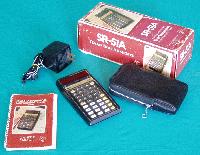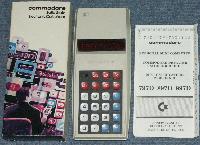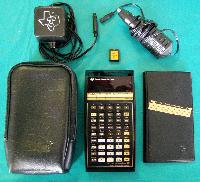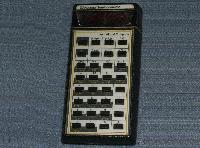 This Keuffel & Esser model 4092-3 slide rule (1932) is the oldest item of
"computing equipment" currently in the collection.
This Keuffel & Esser model 4092-3 slide rule (1932) is the oldest item of
"computing equipment" currently in the collection.Click any photo to view a large high-resolution image.
 This Keuffel & Esser model 4092-3 slide rule (1932) is the oldest item of
"computing equipment" currently in the collection.
This Keuffel & Esser model 4092-3 slide rule (1932) is the oldest item of
"computing equipment" currently in the collection.
Donated by the estate of Robert Warren Bowman, PE.
 This Hughes Owens Co. Ltd 1760 (1952) at 4 inches long is the cutest little
slide rule I've seen. Manufactured by Sun Hemmi in Japan, it was sold in Canada
under the Hughes Owens name.
This Hughes Owens Co. Ltd 1760 (1952) at 4 inches long is the cutest little
slide rule I've seen. Manufactured by Sun Hemmi in Japan, it was sold in Canada
under the Hughes Owens name.
Donated by Bob Sinclair.
 The Geotec Versalog II engineering slide rule. Manufactured by Sun Hemmi in
Japan, this is a well crafted bamboo rule with a quality leather case and very
comprehensive book.
The Geotec Versalog II engineering slide rule. Manufactured by Sun Hemmi in
Japan, this is a well crafted bamboo rule with a quality leather case and very
comprehensive book.
Donated by G. Morrison.
 A pair of slightly different Sterling Acumath #400 Slide Rules.
A pair of slightly different Sterling Acumath #400 Slide Rules.
Donated by C. Dunfield, and the estate of Robert Warren Bowman, PE.
 These boards and manual are all that remains of an Olivetti Programma 101
desktop programmable calculator (1963), which I am told was disassembled many
years ago. This machine did not use Integrated Circuits, but instead had
resistor-transistor logic modules. You can read
about it's capabilities and programming techniques in the
manual (3.7M PDF).
These boards and manual are all that remains of an Olivetti Programma 101
desktop programmable calculator (1963), which I am told was disassembled many
years ago. This machine did not use Integrated Circuits, but instead had
resistor-transistor logic modules. You can read
about it's capabilities and programming techniques in the
manual (3.7M PDF).
 The Tektronix Model 31 is an early (1973) programmable desk calculator/computer.
This machine does not use a microprocessor, but instead has several boards full
of custom LSI logic. It is suprisingly capable considering the technology.
Advanced features such as trignometric function, factorial, full conditional
branching and subroutines are available. Programs can range up to 5000 steps,
depending on installed memory (this machine supports 2048 steps - the base
model is 512 steps). This machine also incorporates an internal printer and
tape drive for program storage.
Here is a view of the back.
The Tektronix Model 31 is an early (1973) programmable desk calculator/computer.
This machine does not use a microprocessor, but instead has several boards full
of custom LSI logic. It is suprisingly capable considering the technology.
Advanced features such as trignometric function, factorial, full conditional
branching and subroutines are available. Programs can range up to 5000 steps,
depending on installed memory (this machine supports 2048 steps - the base
model is 512 steps). This machine also incorporates an internal printer and
tape drive for program storage.
Here is a view of the back.
This is
the oldest functioning electronic computer currently in the collection.
1975 Tektronix Catalog pages:
1,
2,
3,
4,
5,
6 (100-150k each JPG)
Donated by Matthias Wandel.
 This Sperry-Remington 825GT is an example of an early (1974) battery powered
handheld calculator using vacume fluorescent displays.
This Sperry-Remington 825GT is an example of an early (1974) battery powered
handheld calculator using vacume fluorescent displays.
Donated by Bill VanDijk.
 The Sinclair Scientific (1975) is one of the earliest affordable scientific
calculators. It operates in reverse polish notation, with only a scientific
format display of 5 mantissa and 2 exponent digits. The scientific functions
are implemented without a special processor, which reduced cost, however the
results have been described as "at best an approximation".
The Sinclair Scientific (1975) is one of the earliest affordable scientific
calculators. It operates in reverse polish notation, with only a scientific
format display of 5 mantissa and 2 exponent digits. The scientific functions
are implemented without a special processor, which reduced cost, however the
results have been described as "at best an approximation".
Donated by Richard Parsons.
 The Lloyds Accumatic 306 (1975) and Accumatc 20 are typical of the early large
4-function handheld calculators with green florecent display.
The Lloyds Accumatic 306 (1975) and Accumatc 20 are typical of the early large
4-function handheld calculators with green florecent display.
Donated by Doug Terry & Markus Wandel.
 The Casio "Memory A1" and "Personal M1" calculators are examples of typical
4-function green florecent display calculators by Casio in the mid 70s. The
"Memory A1" operates all functions, including the display from a single 1.5v
cell.
The Casio "Memory A1" and "Personal M1" calculators are examples of typical
4-function green florecent display calculators by Casio in the mid 70s. The
"Memory A1" operates all functions, including the display from a single 1.5v
cell.
Donated by Markus Wandel.
 This Unitrex UC-75 is an early scientific calculator with florecent display.
If you have information about this calculator, please
contact me. Donated by Markus Wandel
This Unitrex UC-75 is an early scientific calculator with florecent display.
If you have information about this calculator, please
contact me. Donated by Markus Wandel
 The Unitrex Micro-6 and the Intertronic Mini-8 are examples of generic 4
function LED calculators manufactured by Eiko Business Machines in the mid
70s - as you can see, these two machines were built in the same plastic mold.
The Unitrex Micro-6 and the Intertronic Mini-8 are examples of generic 4
function LED calculators manufactured by Eiko Business Machines in the mid
70s - as you can see, these two machines were built in the same plastic mold.
Donated by Markus Wandel.
 The Texas Instruments SR-51A (1975) is an example of a line of TI scientific
calculators decended from the original SR-50.
Here is a closeup of the SR-51A.
Here is a simulator for the original SR-50.
The Texas Instruments SR-51A (1975) is an example of a line of TI scientific
calculators decended from the original SR-50.
Here is a closeup of the SR-51A.
Here is a simulator for the original SR-50.
Donated by G. Morrison
 The Texas Instruments SR-40 (1976) is another example of an early TI
scientific calculator. This is a lower-cost design, and has all of the
electronics in a single module attached directly to the LED stick.
The Texas Instruments SR-40 (1976) is another example of an early TI
scientific calculator. This is a lower-cost design, and has all of the
electronics in a single module attached directly to the LED stick.
Donated by the estate of Robert Warren Bowman, PE.
 Possibly the most popular TI calculator ever, the TI-30 was a cost reduced
version of the SR-40, the main differences being the lack of a rechargable
battery pack (available as an option), and a cheaper front panel.
Manual (3.8M PDF)
Possibly the most popular TI calculator ever, the TI-30 was a cost reduced
version of the SR-40, the main differences being the lack of a rechargable
battery pack (available as an option), and a cheaper front panel.
Manual (3.8M PDF)
Donated by Chris Witkowski.
 The Texas Instruments SR-56 (1976) is one of TIs early handheld programmable
calculators.
The Texas Instruments SR-56 (1976) is one of TIs early handheld programmable
calculators.
Donated by Ralph Curtis.
 The Radio Shack EC-220 (1976) is a rebadged Rockwell 8R (1975). This is a
typical L.E.D. display 4 function handheld calculator.
The Radio Shack EC-220 (1976) is a rebadged Rockwell 8R (1975). This is a
typical L.E.D. display 4 function handheld calculator.
 The National Semiconductor "Mathematician" (1976) is another early scientific
calculator, and is one of the few non-HP calculator which employ RPN (Reverse
Polish Notation).
The National Semiconductor "Mathematician" (1976) is another early scientific
calculator, and is one of the few non-HP calculator which employ RPN (Reverse
Polish Notation).
Donated by Markus Wandel.
 This Commodore 797D is a good example of a basic 4-function calculater made by
the Commodore Calculator company in the early 70s before they switched their
focus to the Personal Electronic Transactor (PET)
computer.
This Commodore 797D is a good example of a basic 4-function calculater made by
the Commodore Calculator company in the early 70s before they switched their
focus to the Personal Electronic Transactor (PET)
computer.
Donated by Stephane Elias.
 The Commodore PR100 (1977) is a good example of a lower-end programmable scientific
calculator. This model features up to 72 programmable "steps" for automating
repetative calculations.
The Commodore PR100 (1977) is a good example of a lower-end programmable scientific
calculator. This model features up to 72 programmable "steps" for automating
repetative calculations.
Donated by Doug Terry.
 This Underwood 585PD is a generic large format desktop printing calculator. I
have been unable to establish a date or obtain other information on it. Please
contact me if you can help.
This Underwood 585PD is a generic large format desktop printing calculator. I
have been unable to establish a date or obtain other information on it. Please
contact me if you can help.
Donated by Tom Wilson.
 The Texas Instruments TI-55 (1977) scientific calculator is one of the last
decendants of the SR-50 line. It features a very rudimentary programming
ability - it can store up to 32 keystrokes, with no branching, looping or
decision making.
The Texas Instruments TI-55 (1977) scientific calculator is one of the last
decendants of the SR-50 line. It features a very rudimentary programming
ability - it can store up to 32 keystrokes, with no branching, looping or
decision making.
Donated by Bill VanDijk.
 The Texas Instruments "Programmable 57" (1977) was TI's lower end programmable
calculator. It features 50 user programmable steps, and an enhancement such
that program labels, goto statements and other inline "data" elements only
occupied a single step location. I used a TI57 during most of my years at
university. The "Making Tracks Into Programming" (2.5M PDF) manual is an excellent
introduction to programming. Here is the reference card
(700k PDF).
The Texas Instruments "Programmable 57" (1977) was TI's lower end programmable
calculator. It features 50 user programmable steps, and an enhancement such
that program labels, goto statements and other inline "data" elements only
occupied a single step location. I used a TI57 during most of my years at
university. The "Making Tracks Into Programming" (2.5M PDF) manual is an excellent
introduction to programming. Here is the reference card
(700k PDF).
Donated by "der Mouse".
 The Texas Instruments "Programmable 58" (1977) was TI's middle range programmable
calculator. The TI58 and TI59 (below) are based on the same design, and are
almost identical (In fact, they came with the same manual).
The TI58 has 1/2 the internal memory (240/480 steps), and lacks the magnetic
cards available on the TI59. The model shown is a 'C' version, which stands
for "Constant Memory" - this calculator retains user written programs when
powered off.
The Texas Instruments "Programmable 58" (1977) was TI's middle range programmable
calculator. The TI58 and TI59 (below) are based on the same design, and are
almost identical (In fact, they came with the same manual).
The TI58 has 1/2 the internal memory (240/480 steps), and lacks the magnetic
cards available on the TI59. The model shown is a 'C' version, which stands
for "Constant Memory" - this calculator retains user written programs when
powered off.
 The Texas Instruments "Programmable 59" (1977) was THE programmable calculator
in the late 70's. Almost a computer - it featured 480/960 user programmable
"steps", and up to 5000 program steps in replaceable ROM modules. It's coolest
feature however was the fact that it could store programs on little magnetic
cards using an internal motorized card reader/writer. Try this
simulator. Manuals for: TI59
(7.5M PDF), Master Library Module (2M PDF) and
PC100-A Interface Description (760k PDF).
Here are schematics.
The Texas Instruments "Programmable 59" (1977) was THE programmable calculator
in the late 70's. Almost a computer - it featured 480/960 user programmable
"steps", and up to 5000 program steps in replaceable ROM modules. It's coolest
feature however was the fact that it could store programs on little magnetic
cards using an internal motorized card reader/writer. Try this
simulator. Manuals for: TI59
(7.5M PDF), Master Library Module (2M PDF) and
PC100-A Interface Description (760k PDF).
Here are schematics.
 The TI-50 (1978) is the first US made "slimline" calculator by Texas Instruments.
The TI-50 (1978) is the first US made "slimline" calculator by Texas Instruments.
 The National Semiconductor "International Computer" (1978) is a standard calculator
with the addition of many conversion operations between various international
standards.
The National Semiconductor "International Computer" (1978) is a standard calculator
with the addition of many conversion operations between various international
standards.
Here is the manual (185k PDF).
Donated by Markus Wandel.
 The HP33C is a scientific programmable introduced in 1979. One of the Hewlett
Packards last LED display models, early models of the 33C featured a unique
construction - the chips were NOT soldered to the board, but help in place
with a foam insert. This proved problematic and later editions used more
conventional construction. Donated by Bill Durrel.
The HP33C is a scientific programmable introduced in 1979. One of the Hewlett
Packards last LED display models, early models of the 33C featured a unique
construction - the chips were NOT soldered to the board, but help in place
with a foam insert. This proved problematic and later editions used more
conventional construction. Donated by Bill Durrel.
 This HP12C Financial/Programmable (1981) is one of Hewlet Packards longest
and best selling calculators.
This HP12C Financial/Programmable (1981) is one of Hewlet Packards longest
and best selling calculators.
Donated by Markus Wandel.
 In 1981, Texas Instruments updated their popular TI-55 to the TI-55-II, with
LCD display, slim packaging and more functions. Unfortunately the keyboard was
noteably horrible, with many people suggesting that the "-II" was an indicator
of how many digits were entered with one keypress.
In 1981, Texas Instruments updated their popular TI-55 to the TI-55-II, with
LCD display, slim packaging and more functions. Unfortunately the keyboard was
noteably horrible, with many people suggesting that the "-II" was an indicator
of how many digits were entered with one keypress.
Donated by Markus Wandel.
 This Texas Instruments TI-66 Programmable (1983) is an example of a later
edition programmable calculator by TI.
This Texas Instruments TI-66 Programmable (1983) is an example of a later
edition programmable calculator by TI.
Donated by the estate of Robert Warren Bowman, PE.
 The Casio SL-800 (1983) is the ONLY true credit card sized calculator ever
made. It meets the ISO-7810 specification for credit card size in length,
width *AND* thickness. This edge-on view shows
(from left to right): A quarter (coin), the SL-800, and two "button" batteries
of the type often used in other "thin" calculators.
The Casio SL-800 (1983) is the ONLY true credit card sized calculator ever
made. It meets the ISO-7810 specification for credit card size in length,
width *AND* thickness. This edge-on view shows
(from left to right): A quarter (coin), the SL-800, and two "button" batteries
of the type often used in other "thin" calculators.
Donated by the estate of Robert Warren Bowman, PE.
 The Canon TP-7 "Pocket Printer" (1984) is a typical handheld printing
calculator from the mid-80's. I found this little guy at the bottom of a
box of cables I purchased at a flea market - The paper cover is missing,
however it appears to work perfectly.
The Canon TP-7 "Pocket Printer" (1984) is a typical handheld printing
calculator from the mid-80's. I found this little guy at the bottom of a
box of cables I purchased at a flea market - The paper cover is missing,
however it appears to work perfectly.
 The "TI-74 BasicCalc" (1985) was a Next Generation programmable calculator
for Texas Instruments. This machine features a full scientific calculator,
and a BASIC programming mode. The BASIC language is very similar to the
extended BASIC of the TI 99/4 home computer.
Here is a view of the circuit board. Manuals
are available on my Texas Instruments page.
The "TI-74 BasicCalc" (1985) was a Next Generation programmable calculator
for Texas Instruments. This machine features a full scientific calculator,
and a BASIC programming mode. The BASIC language is very similar to the
extended BASIC of the TI 99/4 home computer.
Here is a view of the circuit board. Manuals
are available on my Texas Instruments page.
 I still use these 1987 Sharp EL-525 (desktop) and EL-545 (pocket) calculators
from the 80's on a daily basis because in addition to scientific functions,
they also perform hexidecimal arithmetic.
I still use these 1987 Sharp EL-525 (desktop) and EL-545 (pocket) calculators
from the 80's on a daily basis because in addition to scientific functions,
they also perform hexidecimal arithmetic.
 Casio created the first Graphing calculator with the FX-7500 in 1987. This
FX-7500G (1988) is perhaps the most interesting of that early line, because of
the unique folding design, which makes it the smallest graphing calculator of
the time.
Casio created the first Graphing calculator with the FX-7500 in 1987. This
FX-7500G (1988) is perhaps the most interesting of that early line, because of
the unique folding design, which makes it the smallest graphing calculator of
the time.
Here is the Manual (11M PDF)
Donated by Mike Kenzie.
 Later model Texas Instruments printing calculators:
Later model Texas Instruments printing calculators:
Left: TI-5006 II (1994) - Donated by Carl Morrison.
Middle: TI-5032 SVC (1983) - Manual (213k PDF) - Donated by Carl Morrison.
Right: TI-5035 II (1991)
 This TRS-80 Pocket Computer was the ultimate programmable calculator in 1980,
and speaks BASIC. It has it's own page - click the image for more information.
This TRS-80 Pocket Computer was the ultimate programmable calculator in 1980,
and speaks BASIC. It has it's own page - click the image for more information.